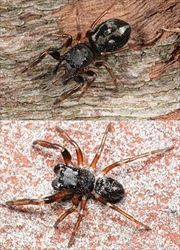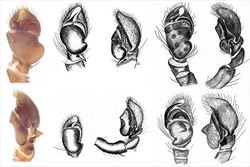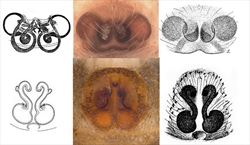
Examples of live Adoxotoma
Illustrator (and ©) G. Anderson

Aspects of the general morphology of Adoxotoma
Illustrators (and ©) B.J. Richardson (CSIRO), M. Zabka (QMB)

Palp morphology of Adoxotoma
Illustrators (and ©) B. J. Richardson (CSIRO), M. Zabka (diag.) (WAMP)

Epigyne morphology of Adoxotoma
Illustrators (and ©) B.J. Richardson (CSIRO), M. Zabka (diag.) (WAMP)
Adoxotoma Simon, 1909
Taxonomy
Adoxotoma has nine Australian species: Adoxotoma bargo, A. chinopogon, A. embolica, A. hannae, A. justyniae, A. nigroolivacea. A. nitida, A. nodosa and A. sexmaculata. There is a single New Zealand species, Adoxotoma forsteri, which is probably misplaced (Żabka, unpubl.) The genus is part of an Australasian clade (Maddison et al 2008) including Arasia, Astia, Helpis, Jacksonoides, Megaloastia, Parahelpis, Sondra and Tauala. Genera from Indonesia (Katya) and the Philippines (Orthrus) may also be part of this group (Maddison 2015). Further information on the genus and described species can be found in Żabka (2001, 2004) and Gardzińska, & Żabka (2010), Richardson and Żabka (2017) and Whyte and Anderson (2017).
Description
Adoxotoma spp. are small to medium-sized spiders, ranging in body size from 3 to 6mm. The carapace is very high, rising to a peak at the posterior lateral eyes, gently sloping to the rear. The upper surface of the male’s cephalothorax can present a frosted appearance. The male has a rounded abdomen with a large, distinct scutum not present in the female. Chelicerae in both males and females may have a single retromarginal tooth with one, two, three or more cusps (unident or fissident) or two or more teeth (plurident) and one or two teeth opposite on the promargin. The male’s maxilla has an antero-lateral process in some species. The first pair of legs is much stronger than the others, with many pairs of long, strong spines on the tibia and tarsus and sometimes on the patella.
The male’s palp has a rather massive, dagger-like embolus, nearly always curved in a clockwise direction (from promargin towards retromargin). The embolus and associated sclerite is bifurcate in some species. The tegulum has one or more large protuberances, varying in size between species, sometimes directed ventrally (projecting outwards from the face of the palp) other times at the proximal base of the tegulum directed either right or left. The tegulum covers most of the ventral face of the palpal organ. The palpal tibia is short, usually with a hooked retro-lateral tibial apophysis and other processes.
The female’s epigyne varies in form between species. There is a single, median, variously-sized atrium with the insemination ducts opening on the edges. The ducts travel posteriorly to join the anterior edges of kidney-shaped spermathecae. These are located close to the epigastric fold, which includes a small median pouch.
Biology
Adoxotoma is found in rainforest, wet sclerophyll forest and arid regions, on the ground, in leaf litter or under stones and rocks. Many species are dark with flecks of white, especially on the carapace. They may not be ant mimics as such, but are somewhat ant-like in appearance.
Distribution
In Australia, Adoxotoma is found in New South Wales, Australian Capital Territory, Victoria, South Australia, Queensland and Western Australia.
References
Davies, V.T. & Żabka, M. 1989. Illustrated keys to the genera of jumping spiders (Araneae: Salticidae) in Australia. Memoirs of the Queensland Museum 27, 189-266.
Gardzińska, J. & Żabka, M. 2010. A new genus and five new species of Astieae (Araneae: Salticidae) from Australia, with remarks on distribution. Zootaxa 2526, 37-53.
Richardson, B.J. & Żabka, M. 2017. Salticidae. Arachnida: Araneomorphae. Canberra, Australian Faunal Directory. Australian Biological Resources Study, at https://biodiversity.org.au/afd/taxa/SALTICIDAE.
Whyte, R. & Anderson, G. 2017. A Field Guide to Spiders of Australia. CSIRO Publishing: Clayton.
Żabka, M. 2001. Salticidae (Arachnida: Araneae) from the Oriental, Australian and Pacific regions, XIV. The genus Adoxotoma Simon. Records of the Western Australian Museum 20, 323-332.
Żabka, M. 2004. Salticidae (Arachnida: Araneae) of New Zealand. Genus Adoxotoma Simon, 1909. Annales Zoologici, Warszawa 54, 591–594.
* The information sheet should be interpreted in the context of the associated diagrams and photographs. Diagrams explaining anatomical terms can be found in the ‘Salticidae’ pictures at the beginning of the list of genera.